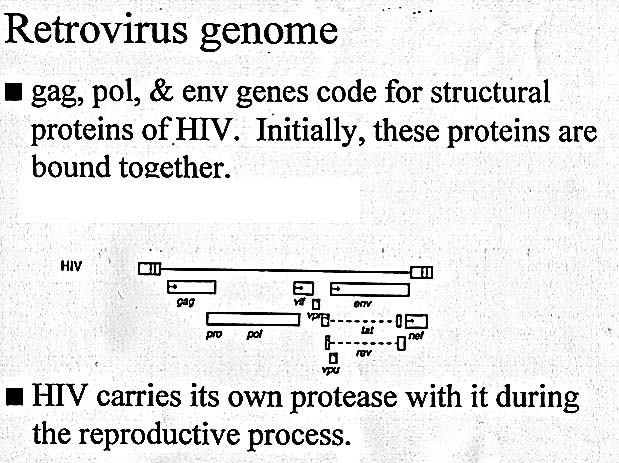A Cure for HIV in the next
decade?
Chris Armstrong
Raman Battish
John Billelo
Akeed Habeeb
The importance of a cure:
- Reported cases as of June 1997 in the
U.S.
- Since 1991, an average if 40,000 patients die a year from AIDS related
illnesses.

Life Cycle of the AIDS Virus:
- 2 strands of RNA and some enzymes
- virus binds to both CD4 and co-receptors of T-cells
- when virus enters cell, its RNA is converted into double stranded DNA
by an enzyme called reverse transcriptase
It is at this point where special drugs, reverse transcriptase
inhibitors, are used.
Two examples of these drugs are AZT and
3TC.
AZT = 3'-Azido-3'deoxythymidine
AZT is a prodrug which means that it is taken in its inactive form,
then
converted to its active form in the body through several metabolic steps.
During this step, three phosphate groups are attached to the AZT
molecule.
This activated AZT molecule inserts itself into the growing DNA strand,
preventing the completion of the HIV's replication.
A drawback of AZT is that the second phosphate group is added very slowly
which leads to the accumulation of the monophosphate AZT molecule, which
leads to the harmful side-effects associated with AZT.
Also, with therapy of only AZT alone, the virus becomes resistant to the
drug.
This calls for a need to combine AZT with other drugs.
However, for many on combination-antiretroviral therapy the demands of
the treatments are hard to comply with consistently. This is because many
pills need to be taken each day, some pills have to be taken with food,
some without food, etc.
A new drug has just been approved (September 29, 1997), Combivir,
which combines
AZT and 3TC in one pill that only needs to be taken twice a day
Integrase = the protein that incorporates the virus's DNA into
the host cell's genome.
Crtitical Step : genetically altered HIV lacking the integrase gene
cannot infect cells.
ADVANTAGES:
- No interase activity in normal cells
- Attacks virus at a different point in its life cycle
DISADVANTAGES:
- Acts only for a single brief step in life cycle
- "Escape Mutants"
ZINTEVIR:
- Aronex pharmaceuticals
- Stable oligonucleotide administered via IV-infusion
Side effects:
- heartburn
- headache
- dizziness
- slowed heart rate
- bleeding gums
- Clinical trials are succesful

- Thus, if we can inhibit these proteases from cutting the
gag-pol-env complex, viral incorporation will not occur.
- Stop HIV's progression in a host/patient.
Some experimental protease inhibitors:
- Indinvir
- Nelfinavir
- Ritonavir
- Saquinavir
- Recommended for use with RT and integrase
inhibitors
Commercially available protease inhibitor
Present day protease inhibitors are not a cure, but a
treatment.
ADVANTAGES:
- Experts agree a vaccine is the best solution
Global effects:
- affordable
- readily available
- Eradication (example: smallpox)
DISADVANTAGES:
- Large variability of the HIV.
- Mutates repidly as infection spreads.
- Unknown infectivity process.
- Immune response may be not afford immunity.
CURRENT VACCINES:
SIV Vaccine:
- Dr. Ronald Desrosiers
- Simian immunodeficiency virus (HIV for monkeys)
- Classic approach - attenuated form of virus (nef gene removed)
- Succesful trials in monkeys
- Application in humans?
Remune:
- Jonas Salk
- Inactivated HIV-1 virus with part of viral envelope (gp-120)
removed
- Clinical trials have found it to be effective
TREATMENT:
- Combination therapy, using all three strategies (Reverse Transcriptase
Inhibitors, Integrase Inhibitors, and Protease Inhibitors), will reduce
replication rate of HIV and thus lower the number of mutant strains
- However, these are treatments, NOT cures. These may
extend patient lives, but will not eradicate HIV.
CURE:
- The only way to cure HIV (other than safer sexual and
hypodermic needle practices), is to find a vaccine.
- However, our investgations found no evidence pointing towards the
acquisition
of a working HIV vaccine within the near future.
Click here to return to the Introduction
Page

